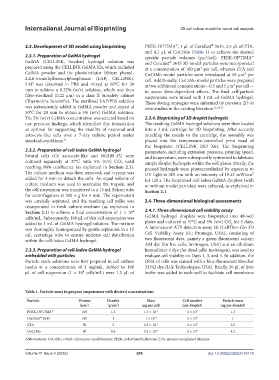Page 267 - v11i4
P. 267
International Journal of Bioprinting 3D cell culture model for neural cell analysis
®
2.3. Development of 3D model using bioprinting PEEK-OPTIMA™, 1 μL of Ceridust 3615, 2.5 μL of ZTA,
and 4.2 μL of CoCrMo (Table 1) to achieve the desired
2.3.1. Preparation of GelMA hydrogel specific particle volumes (μm /cell). PEEK-OPTIMA™
3
GelMA (CELLINK, Sweden) hydrogel solution was and Ceridust 3615 3D model particles were incorporated
®
prepared using the CELLINK GelMA Kit, which included at a concentration of 100 μm³ per cell, whereas ZTA and
GelMA powder and the photoinitiator lithium phenyl- CoCrMo model particles were introduced at 50 μm³ per
2,4,6-trimethylbenzoylphosphinate (LAP; CELLINK). cell. Additionally, CoCrMo model particles were prepared
LAP was dissolved in PBS and mixed at 60°C for 20 at two additional concentrations—0.5 and 5 μm³ per cell—
min to achieve a 0.25% (w/v) solution, which was then to assess dose-dependent effects. The final cell/particle
filter-sterilized (0.22 μm) in a class II biosafety cabinet suspensions were mixed with 1 mL of GelMA hydrogel.
(Thermoline Scientific). The sterilized LAP/PBS solution These dosing strategies were informed by previous 2D in
was subsequently added to GelMA powder and mixed at vitro studies in the existing literature. 26,34,35
50°C for 20 min to obtain a 5% (w/v) GelMA solution.
The 5% (w/v) GelMA concentration was selected based on 2.3.4. Bioprinting of 3D droplet hydrogels
our previous findings, which identified this formulation The resulting GelMA hydrogel solutions were then loaded
as optimal for supporting the viability of neuronal and into a 3 mL cartridge for 3D bioprinting. After securely
astrocyte-like cells over a 7-day culture period under attaching the nozzle to the cartridge, the assembly was
standard conditions. 33 placed into the temperature-controlled print head of
the bioprinter (CELLINK BIO X6). The bioprinting
2.3.2. Preparation of cell-laden GelMA hydrogel parameters, including extrusion pressure, printing speed,
Neural cells (C6 astrocyte-like and NG108-15) were and temperature, were subsequently optimized to fabricate
cultured separately at 37°C with 5% (v/v) CO₂ until simple droplet hydrogels within the well plates. Finally, the
reaching 80% confluence (as explained in Section 2.1). printed hydrogels were photocrosslinked by exposure to
The culture medium was then removed, and trypsin was UV light at 365 nm with an intensity of 19.42 mW/cm²
added for 3 min to detach the cells. An equal volume of for 120 s. The bioprinted cell-laden GelMA droplets (with
culture medium was used to neutralize the trypsin, and or without model particles) were cultured, as explained in
the cell suspension was transferred to a 15 mL Falcon tube Section 2.1.
for centrifugation at 300 × g for 5 min. The supernatant
was carefully aspirated, and the resulting cell pellet was 2.4. Three-dimensional biological assessments
resuspended in fresh culture medium (as explained in
Section 2.1) to achieve a final concentration of 1 × 10⁴ 2.4.1. Three-dimensional cell viability assay
cells/mL. Subsequently, 100 μL of this cell suspension was GelMA hydrogel droplets were bioprinted into 48-well
added to 1 mL of GelMA hydrogel solution. The mixture plates and cultured at 37°C and 5% (v/v) CO for 5 days.
2
was thoroughly homogenized by gentle aspiration in a 15 A luminescent ATP detection assay kit (CellTiter-Glo 3D
mL centrifuge tube to ensure uniform cell distribution Cell Viability Assay Kit; Promega, USA), consisting of
within the cell-laden GelMA hydrogel. two fluorescent dyes, namely a green fluorescent calcein
AM dye (for live cells; Invitrogen, USA) and an ethidium
2.3.3. Preparation of cell-laden GelMA hydrogel homodimer-1 dye (for dead cells; Invitrogen), was used to
embedded with particles evaluate cell viability on Days 1, 3, and 5. In addition, the
Particle stock solutions were first prepared in cell culture DNA of cells was stained with a blue-fluorescent Hoechst
media at a concentration of 1 mg/mL. Added to 100 33342 dye (Life Technologies, USA). Briefly, 50 μL of lysis
μL of cell suspension (1 × 10⁴ cells/mL) were 1.3 μL of buffer was added to each well to facilitate cell membrane
Table 1. Particle mass to prepare suspensions with desired concentrations
Particle Volume Density Mass Cell number Particle mass
(μm ) (g/cm ) (μg per cell) (per droplet) (μg per droplet)
3
3
PEEK-OPTIMA™ 100 1.3 1.3 × 10 –4 1 × 10 4 1.3
®
Ceridust 3615 100 1 1 × 10 –4 1 × 10 4 1
ZTA 50 5 2.5 × 10 –4 1 × 10 4 2.5
CoCrMo 50 8.4 4.2 × 10 –4 1 × 10 4 4.2
Abbreviations: CoCrMo, cobalt–chromium–molybdenum; PEEK, polyetheretherketone; ZTA, zirconia-toughened alumina.
Volume 11 Issue 4 (2025) 259 doi: 10.36922/IJB025180174

